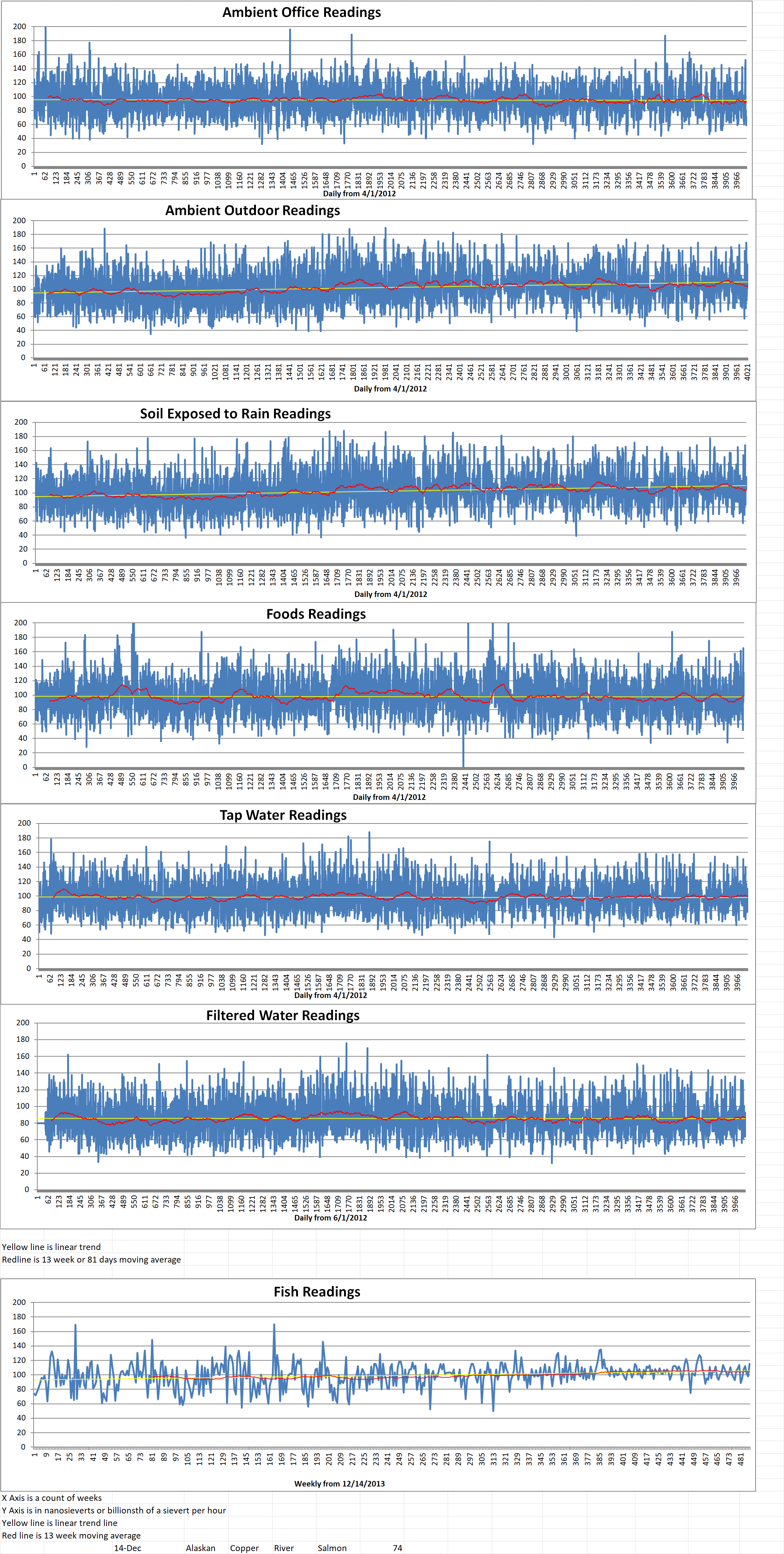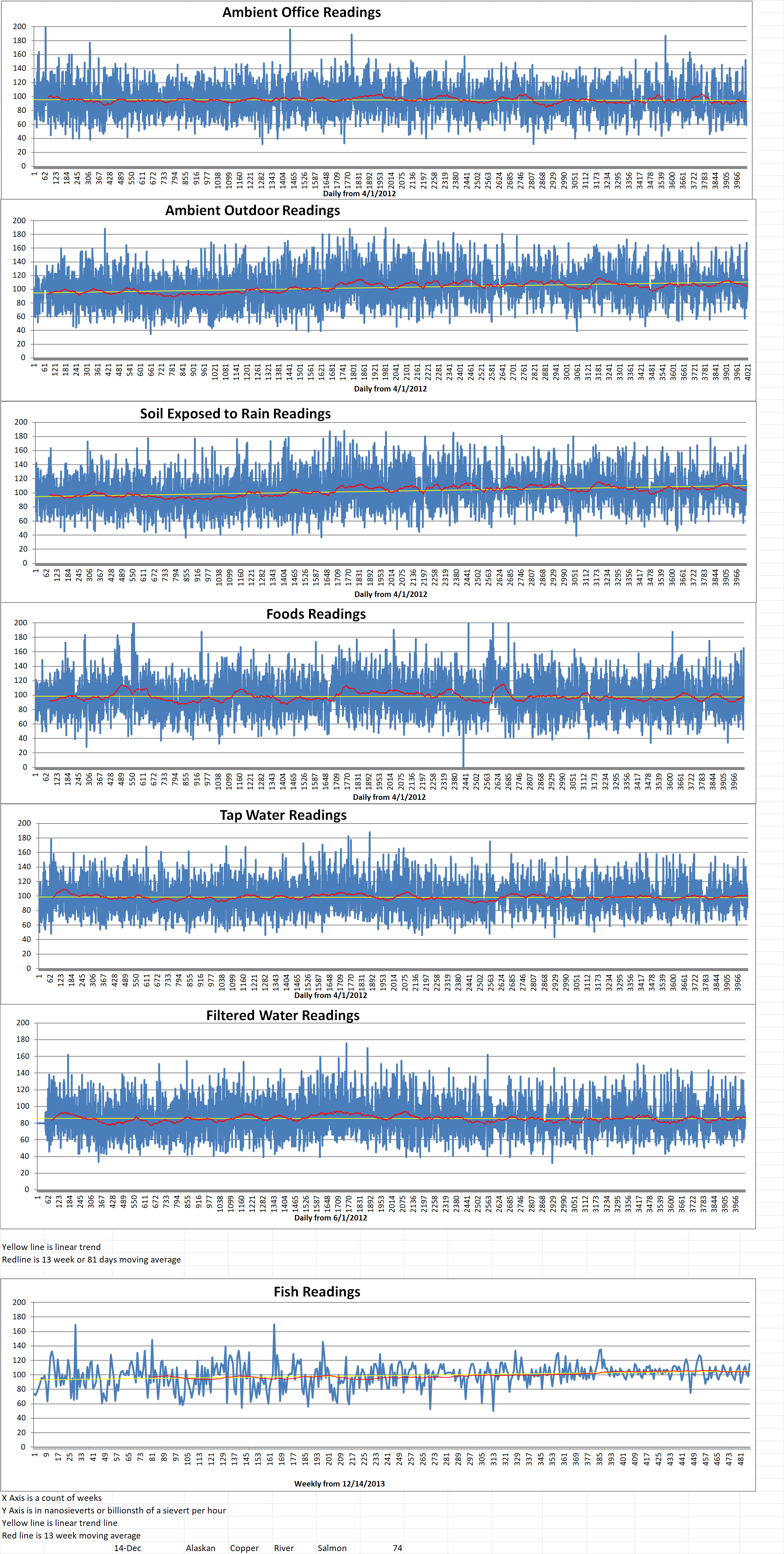Blog
-

Geiger Readings for July 06, 2023
Ambient office = 61 nanosieverts per hour
Ambient outside = 102 nanosieverts per hour
Soil exposed to rain water = 106 nanosieverts per hour
Jalapeno pepper from Central Market = 100 nanosieverts per hour
Tap water = 83 nanosieverts per hour
Filter water = 70 nanosieverts per hour
-

Radioactive Waste 910 – University of Manchester Researchers Find That Some Types Of Bacteria Would Improve Containment Of Nuclear Waste
Certain microbes can use radionuclides such as uranium and neptunium instead of oxygen. In the process, they convert the radionuclides from soluble forms to insoluble forms which makes them less mobile. This should improve our confidence in radioactive waste disposal plans according to Jonathan Lloyd. Lloyd is a geomicrobiologist at the University of Manchester in the U.K. He presented his research at the annual meeting of the Microbiology Society in Edinburgh.
The U.K. has accumulated about six million cubic yards of nuclear waste. This would be enough to fill London’s Wembley stadium four times. Most of it is currently stored in ponds and silos at ground level at Sellafield in Cumbria. The U.K. government plans to dispose of the most highly radioactive waste deep underground in repositories encased in cement. However, the government has yet to select a site for the repository. The plans take into account physical and chemical properties to stop radioactive material from escaping for hundreds of thousands of years. However, biological properties and processes are not included in the planning.
Cement has a pH of about eleven. It has been thought that this would result in alkaline conditions that would make growth of microbes impossible. In order to verify this theory, Lloyds team investigated a lime kiln site in the U.K.’s Peak District in order to see whether microbes could be found growing in conditions similar to those that would be found in a nuclear waste disposal site. He said, “We went to see if there was biology there and there was. We found they could grow at pH values you would probably find developing around these cementitious waste forms. “Radiation levels found at nuclear waste dumps don’t kill these bacteria, they stimulate them.” The radiation levels typically found at nuclear waste dumps do not seem to bother bacteria either. “It does not kill them. If anything, it actually stimulates the microbes.
The study found that the way bacteria process nuclear waste products means that this hazardous material is less likely to leak into the environment. Some nuclear waste contains cellulose. This material can break down to form isosaccharinic acid (ISA) under alkaline conditions. ISA can form a soluble complex with uranium which helps it leak out of a nuclear waste repository. However, bacteria seem to use ISA as a carbon source which keeps radionuclides in a solid form. This means that they remain in the repository.
Microbes may also help prevent radioactive gases from escaping. Hydrogen produced by reactions in the waste repositories can build up pressure and cause them to crack open or explode. However, microbes can consume hydrogen and keep the levels of hydrogen down. They can also grow in fractures in the rock. This process results in the formation of biofilms which clog pores in the rock.
Lloyd said, “At the moment, they have safety case models that are built on chemistry and physical containment. If you start including the biology, it means that those models are actually overly conservative, which is a good thing.” -
Nuclear News Roundup July 05, 2023
US intelligence assessment says Iran not currently developing nuclear weapons timesofisrael.com
Turkey ‘aiming for 20 GW of nuclear by 2050s’ world-nuclear-news.org
Backlash builds as Japan prepares to release wastewater from Fukushima nuclear plant npr.org
Wagner sought nuclear ‘backpacks’ -Ukraine intelligence chief news.yahoo.com
-

Geiger Readings for July 05, 2023
Ambient office = 63 nanosieverts per hour
Ambient outside = 136 nanosieverts per hour
Soil exposed to rain water = 123 nanosieverts per hour
English cucumber from Central Market = 131 nanosieverts per hour
Tap water = 78 nanosieverts per hour
Filter water = 64 nanosieverts per hour
-

Nuclear Weapons 824 – Missing Russian Nuclear Weapons
Before it collapsed in 1991, the Soviet Union (S.U.) manufactured more than twenty-seven thousand nuclear weapons. They also produced more than enough weapons grade uranium and plutonium to make another eighty-one thousand nuclear weapons. The S.U. suffered severe economic distress, widespread corruption, lax security and dependency on the bureaucratic. These factors raise the question of whether some nuclear weapons and/or material may have been lost or stolen from their arsenal.
The former Soviet republics of Belarus, Kazakhstan, and Ukraine were armed with Soviet nuclear weapons. All of these Soviet-era nuclear weapons were returned to post-communist Russia in the 1990s after the fall of the S.U. Fears remain over how the weapons-grade stockpiles of uranium and plutonium could be used. A far greater fear is whether or not all the old S.U. nuclear weapons have been properly accounted for. The International Atomic Energy Agency (IAEA) has reported more than one hundred nuclear smuggling incidents since 1993. Eighteen of those incidents involved highly enriched uranium.
In the late 1990s, Alexander Lebed claimed that the Russian military lost track of over one hundred small Soviet nuclear bombs referred to as “suitcase nukes.” Lebed said that each of these weapons had a yield of one kiloton. They were capable of killing as many as one hundred thousand people. They could be carried and detonated by a single person.
Russia denied Lebed claims. They said that he may have mistaken “dummy small-scale” training devices for actual weapons. In the twenty-four years since Lebed’s report, there have been no verified examples of any Soviet-era suitcase bombs being discovered. Fortunately, no such weapons have been detonated by terrorist organizations.
However, at least two Soviet nuclear weapons have been lost. Both of them are still aboard the Soviet nuclear submarine Komsomolets (K-278) which was put into service in 1984. On April 7th, 1989, the K-278 was operating at a depth of one thousand two hundred and sixty-six feet when a fire broke out. The inexperienced crew was unable to deal with the problem, which was exacerbated by a lack of a dedicated damage control party.
The K-278 was able to surface but the abrupt pressure change caused the top hatch to be blown off. This threw two crewmembers out of the chamber. The K-278 soon sank. In addition to its nuclear reactor, it carried two nuclear armed Shkval torpedoes. Norway pressured the Soviets to find the K-278 and they conducted a deep-sea search. The location of the sunken submarine was discovered in June of 1989.
Between 1989 and 1998, seven expeditions were conducted to secure the reactor against leakages of radioactive materials and to seal the torpedo tubes.
If a terrorist group could obtain a Soviet suitcase bomb, they could destroy a major city anywhere in the world. However, this presupposed that the terrorists had the technical expertise to activate and detonate such a bomb. Even if they did not, they could dismantle the bomb to obtain the radioactive materials it contained to construct a dirty bomb. Dirty bombs just use conventional explosives with a shell of radioactive materials. Distributed over a wide area, the radioactive fallout from such a bomb could render a major city uninhabitable. -
Nuclear News Roundup July 04, 2023
South Korea’s Yoon pushes for strong resolve against North’s nuclear ambitions at NATO summit apnews.com
First Australian Sailors Graduate from Nuclear Power School, Set to Serve on U.S. Navy Subs in Hawaii usni.org
Medvedev threatens to strike three Ukrainian nuclear power plants and nuclear facilities in Europe news.yahoo.com
Pro-nuclear energy EU states ask for ‘level playing field’ with renewables finance.yahoo.com
-

Geiger Readings for July 04, 2023
Ambient office = 59 nanosieverts per hour
Ambient outside = 106 nanosieverts per hour
Soil exposed to rain water = 105 nanosieverts per hour
Corn from Central Market = 122 nanosieverts per hour
Tap water = 110 nanosieverts per hour
Filter water = 93 nanosieverts per hour
-

Nuclear Reactors 1242 – Consolidated Uranium Incorporated Is Reopening The Tony Mine In Utah To Ascertain Levels Of Uranium and Vanadium
Consolidated Uranium Incorporated (CU) is based in Vancouver, B.C., Canada. It has announced the start of a set of comprehensive work programs. One such program involves the reopening of the underground workings of its Tony M uranium mine. It has been fifteen years since the mine last produced uranium. CU also plans to investigate the vanadium potential of the underground Tony M mine.
The Tony M mine is fully developed and permitted. It produced almost one million pounds of U3O8 during two different periods of operation from 1979-1984 and from 2007-20008. The Tony M is one of three past-producing uranium mines in Utah owned by CU.
Historically, it had been thought that there was no significant vanadium in the mine. However, during the process of completing a NI 43-101 technical report on the project, an inverse relationship between uranium and vanadium mineralization was discovered. This resulted in a recommendation by SLR International Corporation, which wrote the technical report, to reopen the underground for a sampling program as well as carrying out a drilling program.
Martin Tunney is the President and COO of CU. He said, “We view the reopening of the underground as a first step in the restart of the Tony M Mine. Any vanadium mineralization of economic value would allow us to reach that goal that much faster.”
The NI 43-101 technical report for the Tony M is dated September 9, 2022. It estimates indicated mineral resources of six million six hundred thousand pounds of U3O8 and inferred resources of two million two hundred thousand pounds. The 2023 drilling program will include as many as fifty-nine vertical drill holes, totaling about thirty-eight thousand feet across the deposit. The underground sampling programs are designed to collect detailed information on vanadium mineralization with the ultimate goal of calculating a vanadium mineral resource. It might also allow for some of the current estimated mineral resources to be converted from the inferred to the indicated category.
Phil Williams is the Chairman and CEO of CU. He said, “With uranium market fundamentals showing significant strength and the unquestionable need and political support for domestic US uranium production, we believe advancing the Tony M project toward a near term production decision is the correct course of action. The programs announced today will not only provide detailed information to guide ultimate mining of the Tony M resource, by potentially upgrading mineral resources into the indicated category and allowing us to evaluate the conditions of the extensive underground workings, but, if successful, could add meaningful value to the deposit through the possible addition of vanadium resources not previously evaluated.”
The Tony M, the Daneros and the Rim mines were part of a portfolio of permitted, past-producing conventional uranium and vanadium mines in Utah and Colorado which CU acquired from Energy Fuels Incorporated in 2021.
Virginia Energy Resources (VER) owns the Coles Hill mine which is the biggest underdeveloped uranium project in the U.S. CU last year agreed to buy VER in a transaction worth about thirty-two million dollars. CU also has past-producing and development projects Argentina, Australia and Canada. -
Nuclear News Roundup July 03, 2023
South Korea’s Yoon pushes for strong resolve against North’s nuclear ambitions at NATO summit apnews.com
First Australian Sailors Graduate from Nuclear Power School, Set to Serve on U.S. Navy Subs in Hawaii usni.org
Medvedev threatens to strike three Ukrainian nuclear power plants and nuclear facilities in Europe news.yahoo.com
Pro-nuclear energy EU states ask for ‘level playing field’ with renewables finance.yahoo.com
